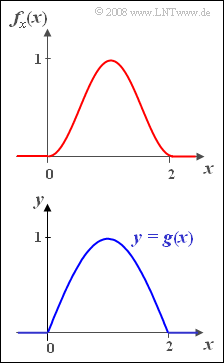Exercise 3.9Z: Sine Transformation
In this task, we consider a random variable $x$ with $\sin^2$& shaped PDF in the range between $x= 0$ and $x= 2$:
- $$f_x(x)= \sin^2({\rm\pi}/{\rm 2}\cdot x) \hspace{1cm}\rm for\hspace{0.15cm}{\rm 0\le \it x \le \rm 2} .$$
Outside of this, the PDF is identically zero.
The mean and rms of this random variable $x$ have already been determined in the Exercise 3.3 :
- $$m_x = 1,\hspace{0.2cm}\sigma_x = 0.361.$$
Another random variable is obtained by transformation using the nonlinear characteristic curve
- $$y= g(x) =\sin({\rm\pi}/{\rm 2}\cdot x).$$
The figure shows in each case in the range $0 \le x \le 2$:
- above the PDF $f_x(x)$,
- below the nonlinear characteristic $y = g(x)$.
Hints:
- The exercise belongs to the chapter Exponentially Distributed Random Variables.
- In particular, reference is made to the page Transformation of random variables and the chapter Expected Values and Moments.
- Given are the two indefinite integrals:
- $$\int \sin^{\rm 3}( ax)\,{\rm d}x = \frac{\rm 1}{ 3 a} \cdot \cos^{\rm 3}( ax)-\frac{\rm 1}{ a}\cdot \cos(ax),$$
- $$\int \sin^{\rm 4}(ax)\,{\rm d}x =\frac{\rm 3}{\rm 8}\cdot x-\frac{\rm 1}{\rm 4 a} \cdot \sin(2 ax)+\frac{\rm 1}{32 a}\cdot \sin(4 ax).$$
Questions
Solution
- Because of the range of values of $x$ and the given characteristic curve, $y$ cannot take values smaller than $0$ or larger than $1$ respectively.
- The value $y = 0$ cannot occur either, however, since neither $x = 0$ nor $x = 2$ are possible.
- With these properties, the result is surely $m_y < 1$, i.e., a smaller value than $m_x = 1$ (see specification).
(2) To solve this task, one could, for example, first determine the PDF $f_y(y)$ and calculate $m_y$ from it in the usual way.
- The direct way leads to the same result:
- $$m_y={\rm E}\big[y\big]={\rm E}\big[g(x)\big]=\int_{-\infty}^{+\infty}g(x)\cdot f_x(x)\,{\rm d}x.$$
- With the current functions $g(x)$ and $f_x(x)$ we obtain:
- $$m_y=\int_{\rm 0}^{\rm 2}\hspace{-0.1cm}\sin^{\rm 3}({\pi}/{ 2}\cdot x)\,{\rm d}x=\frac{\rm 2}{\rm 3\cdot \pi}\cdot \cos^{\rm 3}({\pi}/{ 2}\cdot x)-\frac{\rm 2}{\rm \pi} \cdot \cos({3 \rm \pi}/{\rm 2}\cdot x)\Big|_{\rm 0}^{\rm 2}=\frac{\rm 8}{\rm 3\cdot \pi} \hspace{0.15cm}\underline{=\rm 0.849}.$$
(3) By analogy with point (2) holds:
- $$m_{2 y}={\rm E}[y^{\rm 2}]={\rm E}[g^{\rm 2}( x)]=\int_{-\infty}^{+\infty}\hspace{-0.35cm}g^{2}( x)\cdot f_x(x)\,{\rm d}x.$$
- This leads to the result:
- $$ m_{ 2 y}=\int_{\rm 0}^{\rm 2}\hspace{-0. 15cm}\sin^{\rm 4}({\rm \pi}/{\rm 2}\cdot x)\, {\rm d} x= \frac{\rm 3}{\rm 8}\cdot x-\frac{\rm 1}{\rm 2\cdot\pi}\cdot \sin(\rm \pi\cdot{\it x})+\frac{\rm 1}{\rm 16\cdot\pi}\cdot \sin(\rm 2 \pi\cdot {\it x})\Big|_{\rm 0}^{\rm 2} \hspace{0.15cm}{= \rm 0.75}.$$
- With the result from (2) it thus follows for the rms:
- $$ \sigma_{y}=\sqrt{\frac{\rm 3}{\rm 4}-\Big(\frac{\rm 8}{\rm 3\cdot\pi}\Big)^{\rm 2}} \hspace{0.15cm}\underline{\approx \rm 0.172}.$$
(4) Due to the symmetry of PDF $f_x(x)$ and characteristic curve $y =g(x)$ um $x = 1$ the two domains yield.
- $0 \le x \le 1$ and
- $1 \le x \le 2$
each give the same contribution for $f_y(y)$.
- In the first domain, the derivative of the characteristic curve is positive: $g\hspace{0.05cm}'(x)={\rm \pi}/{\rm 2}\cdot \cos({\rm \pi}/{\rm 2}\cdot x).$
- The inverse function is: $ x=h(y)={\rm 2}/{\rm \pi}\cdot \arcsin( y).$
- Taking into account the second contribution by the factor $2$ we getär the searched PDF in the range $0 \le y \le 1$ ):
- $$f_y(y)= 2\cdot\frac{\sin^{ 2}({ \pi}/{ 2}\cdot x)}{{ \pi}/{ 2}\cdot \cos({ \pi}/{ 2}\cdot x)}\Big|_{\, x={ 2}/{ \pi}\cdot \arcsin( y)}.$$
- outside $f_y(y) is \equiv 0$. This leads to the intermediate result
- $$f_y(y)=\frac{4}{\pi}\cdot \frac{\sin^{2}(\arcsin( y ))}{\sqrt{\rm 1-\sin^{ 2}(\arcsin( y \rm ))}}.$$
- And because of $\sin\big (\arcsin(y)\big) = y$:
- $$f_y(y)=\frac{ 4}{\pi}\cdot \frac{ y^{2}}{\sqrt{1- y^{\rm 2}}.$$
- At the point $y = 0.6$ one obtains the value $f_y(y= 0.6)\hspace{0.15cm}\underline{=0.573}$.
- On the right, this PDF $f_y(y)$ is shown graphically.
(5) The PDF is infinitely large at the point $y = 1$ .
- This is due to the fact that at this point the derivative $g\hspace{0.05cm}'(x)$ of the characteristic curve runs horizontally.
- However, since $y$ is a continuous random größe, nevertheless ${\rm Pr}(y = 1) \hspace{0.15cm}\underline{= 0}$ holds.
This means:
- An infinity point in the PDF is not identical to a Dirac function.
- Or more casually expressed: An infinity point in the PDF is "less" than a Dirac function.
